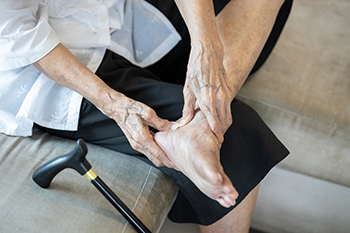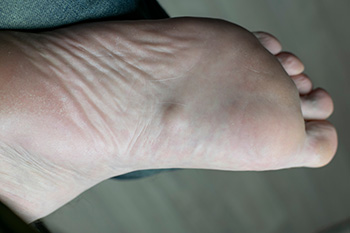Connect With Us
Blog
Items filtered by date: March 2025
Why Balance Declines with Age and Its Impact on the Feet

As the body ages, maintaining your balance can become more difficult due to physical changes that affect stability. Loss of muscle mass weakens the legs and feet, reducing support and increasing the risk of falls. A decline in joint flexibility makes movements less fluid, leading to stiffness that affects foot positioning and walking patterns. Slowed reflexes reduce the body's ability to adjust quickly, making it harder to react to uneven surfaces or sudden shifts in weight. These changes can cause foot fatigue, instability, and a higher risk of sprains or fractures. Strengthening exercises, stretching, and activities like yoga or tai chi help improve muscle function and flexibility. If you notice changes in your feet, it is suggested that you consult a podiatrist who can determine what the cause is, and offer specific exercises to improve balance.
If you need your feet checked, contact David Mansky, DPM of Mansky Podiatry. Our doctor will attend to all of your foot and ankle needs and provide you with quality treatment.
Geriatrics and Podiatry
When people age, some common issues that may occur are bone density loss, dry skin, poor circulation, and rough brittle nails. These issues may also affect your foot health if the necessary steps are not taken to alleviate the problems.
It is important to take care of your feet because feet that are injured or diseased can affect your overall health. Having painful feet hinders your ability to do daily activities or may decrease your willingness to do the things that you need to do.
Visiting Your Geriatrician
As we age, health problems become more likely, so it is essential to visit your doctor for check-ups to ensure that you are doing the best you can to take care of your health. It is recommended to check your feet frequently for any possible cuts, bruises, swelling, corns or any other irregularities.
Taking Care of Elderly Feet
Cracked or dry feet can be treated by applying moisturizer often. It is also important not to wear old socks because the older the sock is, the higher the possibility there will be that there is bacteria there. Wear fresh socks and make sure they fit properly.
Proper foot health means that you can have a more active lifestyle and you will not be bogged down by pain. Foot health also leads to good circulation, which is paramount for overall health.
If you have any questions, please feel free to contact our office located in Hastings, MI . We offer the newest diagnostic tools and technology to treat your foot and ankle needs.
Causes of Pain on the Side of the Foot

Pain on the side of the foot, known as lateral foot pain, can make simply walking or standing difficult. Causes of lateral foot pain include stress fractures, cuboid syndrome, peroneal tendonitis, arthritis, a twisted ankle, and tarsal coalition. Stress fractures develop from repetitive impact, cuboid syndrome occurs when the cuboid bone is injured or dislocated, and peroneal tendonitis results from inflammation of the tendons along the outer ankle. Arthritis can cause joint pain and stiffness, and a twisted ankle may stretch or tear ligaments. Tarsal coalition, which is a congenital condition, can lead to foot pain and limited mobility. Symptoms include sharp or aching pain, swelling, bruising, and difficulty bearing weight. Depending on the cause, a podiatrist may recommend rest, immobilization, custom orthotics, or in some cases, surgery, to relieve pain and restore foot function. Ignoring persistent foot pain can lead to further complications, so early evaluation is important. If you have pain on the side of your foot, it is suggested that you schedule an appointment with a podiatrist for an exam, diagnosis, and treatment.
Foot Pain
Foot pain can be extremely painful and debilitating. If you have a foot pain, consult with David Mansky, DPM from Mansky Podiatry. Our doctor will assess your condition and provide you with quality foot and ankle treatment.
Causes
Foot pain is a very broad condition that could be caused by one or more ailments. The most common include:
- Bunions
- Hammertoes
- Plantar Fasciitis
- Bone Spurs
- Corns
- Tarsal Tunnel Syndrome
- Ingrown Toenails
- Arthritis (such as Gout, Rheumatoid, and Osteoarthritis)
- Flat Feet
- Injury (from stress fractures, broken toe, foot, ankle, Achilles tendon ruptures, and sprains)
- And more
Diagnosis
To figure out the cause of foot pain, podiatrists utilize several different methods. This can range from simple visual inspections and sensation tests to X-rays and MRI scans. Prior medical history, family medical history, and any recent physical traumatic events will all be taken into consideration for a proper diagnosis.
Treatment
Treatment depends upon the cause of the foot pain. Whether it is resting, staying off the foot, or having surgery; podiatrists have a number of treatment options available for foot pain.
If you have any questions, please feel free to contact our office located in Hastings, MI . We offer the newest diagnostic and treatment technologies for all your foot care needs.
Wounds That Don't Heal Need to Be Checked
Preventing and Treating Ankle Injuries in Basketball

Basketball puts intense stress on the ankles due to frequent jumping, cutting, and sudden direction changes. Sprains are the most common injury, occurring when the ligaments overstretch or tear from awkward landings or collisions. High ankle sprains and fractures can also result from forceful twists or falls. Weak ankles, wearing improper footwear, and lack of conditioning increase the risk of injury. Strengthening exercises, balance training, and wearing supportive basketball shoes with proper ankle stability help prevent issues. Taping or bracing provides additional protection for players with a history of injuries. Immediate treatment includes rest, compression, and elevation to reduce swelling and pain. Ignoring an ankle injury can lead to chronic instability and long-term problems. If you have an ankle injury from playing basketball, it is suggested that you see a podiatrist for a proper diagnosis and customized treatment to promote healing and prevent re-injury.
Sports related foot and ankle injuries require proper treatment before players can go back to their regular routines. For more information, contact David Mansky, DPM of Mansky Podiatry. Our doctor can provide the care you need to keep you pain-free and on your feet.
Sports Related Foot and Ankle Injuries
Foot and ankle injuries are a common occurrence when it comes to athletes of any sport. While many athletes dismiss the initial aches and pains, the truth is that ignoring potential foot and ankle injuries can lead to serious problems. As athletes continue to place pressure and strain the area further, a mild injury can turn into something as serious as a rupture and may lead to a permanent disability. There are many factors that contribute to sports related foot and ankle injuries, which include failure to warm up properly, not providing support or wearing bad footwear. Common injuries and conditions athletes face, including:
- Plantar Fasciitis
- Plantar Fasciosis
- Achilles Tendinitis
- Achilles Tendon Rupture
- Ankle Sprains
Sports related injuries are commonly treated using the RICE method. This includes rest, applying ice to the injured area, compression and elevating the ankle. More serious sprains and injuries may require surgery, which could include arthroscopic and reconstructive surgery. Rehabilitation and therapy may also be required in order to get any recovering athlete to become fully functional again. Any unusual aches and pains an athlete sustains must be evaluated by a licensed, reputable medical professional.
If you have any questions please feel free to contact our office located in Hastings, MI . We offer the newest diagnostic and treatment technologies for all your foot and ankle needs.
A Foot Condition Called Plantar Fibroma

Plantar fibroma is a benign growth that develops in the arch of the foot, specifically in the plantar fascia, a thick band of tissue that runs along the bottom of the foot. This condition results in the formation of nodules or lumps, which may be felt as hard, firm areas beneath the skin. The primary cause of plantar fibroma is not well understood, but genetic factors, trauma, or abnormal foot mechanics may contribute to its development. Symptoms typically include localized pain or discomfort, especially when standing or walking, and the presence of a visible lump or thickening in the foot. Over time, the fibroma may become larger, making it more difficult to wear certain shoes or engage in physical activities. If you have a lump on the bottom of your foot, it is suggested that you consult a podiatrist who can provide a proper diagnosis and treatment.
A plantar fibroma may disrupt your daily activities. If you have any concerns, contact David Mansky, DPM of Mansky Podiatry. Our doctor can provide the care you need to keep you pain-free and on your feet.
Plantar Fibroma
A plantar fibroma is a fibrous knot in the arch of the foot. It is embedded in the plantar fascia which is a band of tissue that extends from the heel to the toes along the bottom of the foot. There can be multiple plantar fibromas in the feet at the same time. There are no known causes for this condition. If you have a plantar fibroma, there will be a bump in the arch of your foot that cannot be missed. Any associated pain is most often due to a shoe rubbing against the nodule. Non-surgical options, such as steroid injections, physical therapy, and orthotics should be tried first. Surgery is a last resort and is the only thing that will remove a plantar fibroma entirely. Consult with a podiatrist for a proper diagnosis and to determine the treatment regimen that is right for you.
What Causes a Plantar Fibroma?
While there are no specific causes identified, a plantar fibroma can possibly come from genetic predisposition or the formation of scar tissue that forms from healing the tears in the plantar fascia.
What Are the Symptoms of a Plantar Fibroma?
There will be a noticeable lump in the arch of the foot that may or may not cause pain. If pain is felt, it is typically because a shoe is rubbing up against the lump or when walking or standing barefoot.
Treatment and Prevention
A plantar fibroma will not disappear without treatment, but it can get smaller and be a non-issue. If pain persists, a podiatrist examines the foot and when the arch of the foot is pressed, pain can be felt down to the toes. An MRI or biopsy might be performed to help diagnose or evaluate the plantar fibroma. The following non-surgical options are generally enough to reduce the size and pain of these nodules:
- Steroid injections
- Orthotics
- Physical therapy to help apply anti-inflammatory creams on the bump
Surgery is considered if the mass increases in size and the patient continues to feel pain after non-surgical methods are tried.
If you have any questions please feel free to contact our office located in Hastings, MI . We offer the newest diagnostic tools and technology to treat your foot and ankle needs.
Blog Archives
- April 2025
- March 2025
- February 2025
- January 2025
- December 2024
- November 2024
- October 2024
- September 2024
- August 2024
- July 2024
- June 2024
- May 2024
- April 2024
- March 2024
- February 2024
- January 2024
- December 2023
- November 2023
- October 2023
- September 2023
- August 2023
- July 2023
- June 2023
- May 2023
- April 2023
- March 2023
- February 2023
- January 2023
- December 2022
- November 2022
- October 2022
- September 2022
- August 2022
- July 2022
- June 2022
- May 2022

